Clémentine M. Songe

/ Public




Wenn wir den Begriff des Zimmers in seiner Essenz betrachten, gibt es zwei Merkmale, die „das Zimmer“ vom Raum unterscheiden. Erstens: dem Zimmer wird immer ein Zweck und eine Bedeutung zugewiesen, die von Menschen definiert und durch Design, Ausstattung und Dekoration zum Ausdruck gebracht werden. Das Zimmer ist somit ein Raum, der in Bezug auf jemanden oder etwas betrachtet werden muss. Es wird durch seinen Inhalt definiert.
Das zweite Merkmal ist die Abgrenzung. Durch die Festlegung einer Grenze wird ein bestimmter Teil der räumlichen Umgebung differenziert und als Raum definiert.
Aus den Räumen die Zimmern zu machen, ist eine Besonderheit der menschlichen Spezies. Eine Grenze zu setzen und einen Zweck zu bestimmen, hängt mit der menschlichen Subjektivität und ihrem Bedürfnis nach Stabilität zusammen, ihrem Wunsch, von seiner Umgebung abgetrennt und individualisiert zu werden. Es geht jedoch nicht nur darum, Schutz vor der Umwelt zu schaffen, sondern die Ritualisierung des Lebens zu ermöglichen.
Die Abgrenzung des Zimmers innerhalb einer bestimmten räumlichen Umgebung kann sichtbar oder unsichtbar, weich oder hart, materiell oder immateriell sein. In diesem Sinne sind die Wände nicht verpflichtend, das Dach ist nicht verpflichtend, das einzige unvermeidliche Element ist der
Boden, da wir hilflos unter der Schwerkraft leiden.
So kann die Architektur des Wohnzimmers aufgrund dieser Unvermeidlichkeit auf das Element vom Boden reduziert werden.

Eine inhärente Eigenschaft des Bodens ist die Fähigkeit, verschiedene Mysterien in seinem Hohlraum zu verbergen, während er gleichzeitig eine flache und ruhige Oberfläche bietet, die alle möglichen Szenarien erlaubt.
Dieser ambivalente Charakter des Bodens, der durch die Komplexität seines Querschnitts und die Einfachheit seiner Oberfläche geprägt ist, ist der Ausgangspunkt für die Schaffung des mechanischen Elements, das Objekte und Aktionen aufnimmt. Der Maschinerie des Zimmers als einem lebenden Organismus stehen Muster, Materialien und Dekorationen gegenüber, die auf die heimelige Umgebung anspielen.
 Morana Mažuran
Morana Mažuran
Aufbruch von zu Hause in Haus-Rucker-Co 1967 bis 1983 (Writing series by the Deutsches Architekturmuseum Frankfurt, 1984)


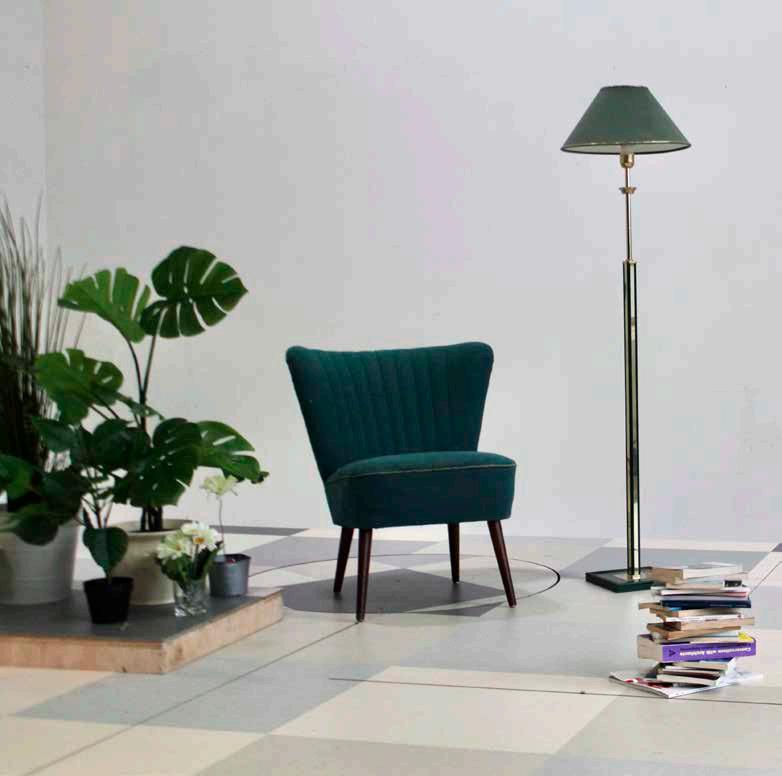

Considering the essential notion of the room, there are two features which distinguish ‚the room‘ from the space. First, it is always assigned the purpose and meaning, which are defined by people and expressed through design, equipment and decoration. The room is thus the space that needs to be put in a reference to someone or something. It is defined through its content.
The second feature is the limitation. By establishing a limit, a certain part of the spatial environment is separated and defined as a room.
Turning spaces into rooms is a distinctive feature of the human species. Establishing a limit and giving a purpose is related to human subjectivity and its need for stability, its desire for being enclosed and individuated from its surroundings. However it is not only about providing the shelter from the environment but also to enable the ritualisation of life.
The limit by which the room has been demarcated within a certain spatial environment can be visible or invisible, soft or hard, material or immaterial. In this sense, the walls are not obligatory, the roof is not obligatory, the only unavoidable element is the floor, as we hopelessly suffer from gravitation.
So due to its unavoidable nature the architecture of the living room can be reduced to the element of the floor.
An intrinsic property of the floor is the ability to hide different mysteries in its cavity, whilst at the same time, it offers a flat and simple surface which allows any possible scenario to happen.
The dual nature of the floor, characterised by the complexity of its section and simplicity of its surface was the starting point to create the mechanical element which accommodates objects and actions. The machinery of the room as a living organism, is counterpointed with` the patterns, materials and decorations alluding to the domestic environment.

The objects assign meaning to the space and are defining its dynamic. People give meaning to objects and define their purpose. The living room as we know it is a space that represents domesticity, a controlled environment.

But what if there are no people, if the objects and the room they inhabit become purpose for themselves?
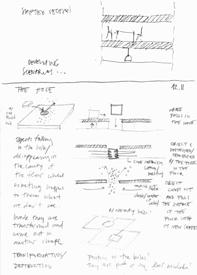
By releasing objects and the room itself from their conventional meanings, we become liberated from conventions and make space for something new to occur. The creation of the Living Room sets the ground for freedom to take place.
Architecture is a discipline of making rooms out of spaces. In general, architecture is an attempt to control our environment, to make it predictable. The design process is a permanent negotiation towards finding a way to deal with elements we can’t control.
In this sense, the architecture of ‘Living Room’ is deconstructing the notion of the room, what questions the architectural discipline as such.
We liberate the objects from their meanings and at the same time ourselves from the meaning of ourselves.
The person is not a main protagonist any more. The space took over the stage. We design and imagine as usual, but the result is unpredictable. This is what makes architecture remain exciting.
Morana Mažuran








Ein Raum mit Eigenleben.
In Living Room wurde die Dynamik des Wohnzimmers erforscht, jenes Ortes, an dem wir uns mit Dingen umgeben, die uns vertraut, intim, wiedererkennbar und sicher erscheinen.
Die vielfältigen Wechselbeziehungen zwischen unserem Leben und diesem Ort zeigen, wie sehr wir unsere gewohnte Umgebung als selbstverständlich ansehen und uns auf sie verlassen, um uns in der Welt „zu Hause“ zu fühlen.
Aus dem kollaborativen Forschungsprozess zum Begriff des Wohnzimmers hervorgegangen, wurde das Wohnzimmer zunächst als Teil einer Bühnenperformance konzipiert. Nach den Aufführungen in den Sophiensælen in Berlin ist Living Room als Rauminstallation im O&O Depot ausgestellt, mit den Inhalten begleitet, die konzeptionelle Entwicklung des Projekts aufdecken.
A room with a life of its own.
In Living Room the dynamics of the living room is explored, that place where we surround ourself with things that feel familiar, intimate, recognizable, safe. Transforming this room into a ‘living room’, a room that makes its own choices.
The various interrelations that appear between our lives and this place are showing how much we take our habitual environment for granted, relying on it in order to feel ‘at home’ in the world.
Resulting from the collaborative research process on the notion of the living room, the Living Room was initially designed as a part of a stage performance. After the performances at Sophiensæle in Berlin, Living Room is shown as a spatial installation at O&O Depot, accompanied by the additional content which reveals the conceptual development of the project.
Public in Private / O&O Depot

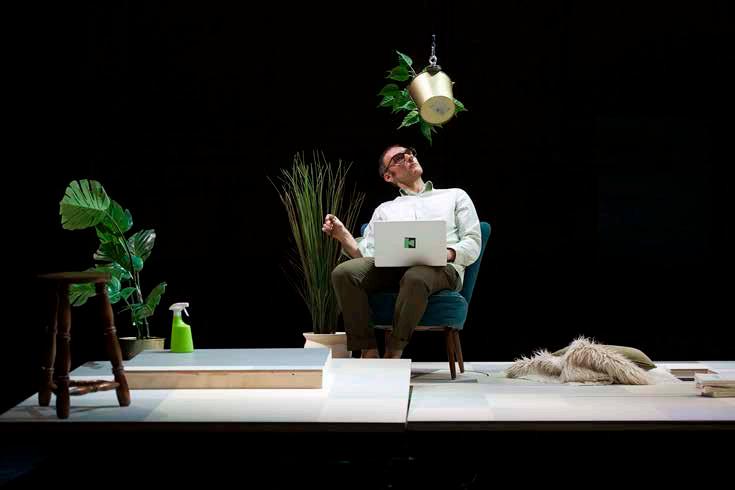
Laut dem Archäologen Chris Gosden verleiht oftmals nicht der Geist den materiellen Dingen ihre Gestalt, vielmehr formen letztere unser Denken. Doch in einer uns wohlgesonnenen Umwelt erkennen wir das nicht, vielmehr beruhigt diese unseren Geist und unterstützt ihn. Doch was, wenn die Umwelt ihre Kooperation einstellt und sich als unabhängiges System nicht um uns kümmert? Was geschieht mit unserem Denken, wenn der living room ein Eigenleben entwickelt und sich unserer Macht entzieht? Was tun wir, wenn die Wände bedrohlich zusammenrücken? Und müssen wir eingreifen, wenn der Teppich Streit mit Sofa anfängt?
Die Verwandlung des Wohnzimmers in einen autonomen, ja sogar feindlich gesonnenen Akteur lässt sich als Metapher für die Umwelt verstehen. In ihr spiegeln sich die Zukunftsszenarien zu Klimawandel und Überbevölkerung, dem Schwinden der natürlichen Ressourcen und, aktuell, der raschen Ausbreitung des Coronavirus. Derartige Prognosen entwerfen eine Zukunft, in der unsere Umwelt in Gestalt von Krankheit, Überschwemmungen, Wüstenbildung, Anstieg des Meeresspiegels und gewaltigen Wanderungsbewegungen zurückschlägt. LIVING ROOM malt die schlimmstmöglichen apokalyptischen Alpträume aus. Die Bewohner des Raums müssen mit wild gewordenen Alltagsgegenständen kämpfen, etwa einer Glühbirne, die an der Wand zerschellt, als wollte sie ihre negativen ökologischen Auswirkungen wiedergutmachen. Die Darsteller wiederum
Archaeologist Chris Gosden suggests that in many cases it is not the mind that imposes its forms on material objects, but rather the latter that gives shape to the forms of thought. In a welcoming environment this fact stays invisible. Here, the mind is calm and supported by its environment. But, what if the surrounding stops to cooperate, if it becomes an autonomous system that shows no consideration for us? What happens with our thoughts when the living room eludes our control and develops a life of its own instead? What do we do when the walls threateningly close together and should we intervene when the carpet and the sofa begin to quarrel?
The transformation of the living room into an autonomous, even hostile protagonist can be read as a metaphor for our environment. It anticipates the upcoming scenarios in regard to the climate change, overpopulation, the disappearance of natural resources and, more recently, the rapid spread of the Corona virus. In these predictions our environment strikes back in the form of illness, flood and desertification, rising of the sea level and immense migration of species. In LIVING ROOM we indulge in the worst apocalyptic nightmare. The residents of the room have to struggle with everyday objects that have gone wild, such as a lightbulb that smashes against the wall as if it wanted to make up for its negative ecological effects. While the actors, like the castaways on the “Raft of Medusa“, fight for their survival in the midst of the unchained elements.
kämpfen wie die Schiffbrüchigen auf dem „Floß der Medusa“ um ihr Überleben inmitten der entfesselten Elemente.
Bei der Gestaltung des „living room“ wird das dramaturgische Prinzip räumlicher – statt zeitlicher – Entfaltung gefolgt. Der Raum selbst treibt die Performance voran, nicht die Geschichte. Er wird zum Hauptakteur, an dessen Veränderungen die Darsteller sich anpassen. Das vertraute Gefühl der Normalität löst sich auf und macht der unheimlichen Erkenntnis Platz, dass der Raum lebt.

Die Interaktion zwischen dem aktiven Haus (sprich dem „living room“) und den Darstellern bildet den Mittelpunkt der Inszenierung. In einem Prozess der allmählichen Steigerung werden die Gesten von Haus und Darstellern immer komplizierter, und es entwickelt sich eine komplexe Choreografie wechselseitiger Abhängigkeit. Es verändert sich nicht allein die physische Umgebung der Inszenierung, sondern auch die Perspektive des Publikums auf das Geschehen: von dem „Dort und Einst“ des Zimmers zum „Hier und Jetzt“ der Theatersituation. Auf diese Weise werden die Zuschauer*innen dahin gebracht, die Wirkweise des Theaters selbst infrage zu stellen. Denn ist das Theater mit all seinen technischen und mechanischen Vorrichtungen letztlich nicht ebenfalls ein lebender Raum oder eine Art Spukhaus?
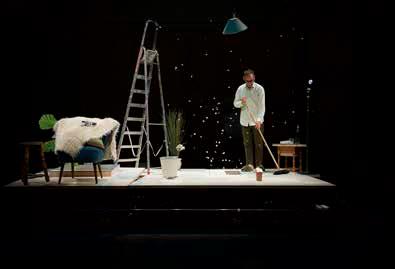
The ‘living room’ follows the dramaturgical principle in which the performance doesn’t unfold in time but in space. It is the space that drives the performance, not the story. It becomes the main actor, while the performers are rather adapting to his dynamics. The intimate feeling of normality dissolves in an uncanny realisation that the room is alive.


The interaction between the „living room” and the performers is the main focus of the performance. In a process of gradual escalation, the gestures of the house and the performers become more and more complicated, resulting in a complex choreography of interdependency.
Not only does the physical environment of the staging change, but also the audience’s perspective of what is happening: from the “there and then” of the room to the “here and now” of the theatre situation. In doing so the audience is brought to question the agency of the theatre itself. After all, isn’t the theatre, with all its technical and mechanical devices, also a living space or a kind of haunted house?
Das Verhältnis von Choreografie und Architektur ist ein besonderes, denn bei beiden geht es um die Organisation menschlicher und nicht menschlicher Körper in Zeit und Raum. Doch auch wenn die beiden künstlerischen Disziplinen das Interesse an der Bewegung und deren raum-zeitlicher Entfaltung teilen, nutzen sie hierfür unterschiedliche Medien und Techniken. Gerade das macht die Verbindung der beiden Disziplinen so aufschlussreich.
In Zusammenarbeit mit den Architekt*innen sind in LIVING ROOM zwei parallele Stränge verfolgt. Zum einen stellt das Stück eine architektonische Erforschung des Wohnzimmers („living room“) dar, seiner Geschichte und seiner räumlichen und zeitlichen Organisationsweise. Diese Studien unterfüttern den „living room“, in dem die Inszenierung letztlich abläuft. Zum anderen erkundet die Inszenierung auf performative Weise die Möglichkeiten der Existenz in einem gegebenen Raum. Doch anstatt das gewöhnliche Leben in einem Raum „darzustellen“, entwerfen wir spekulativ die volle Bandbreite der möglichen Existenzformen darin. Zwischen den beiden Strängen tut sich ein Raum auf, in dem die Inszenierung sich entfaltet.
The relationship between choreography and architecture is specific, since the both are about organising human and non-human bodies in time and space. But even if the two artistic disciplines share an interest in movement and its spatialtemporal development, they use different media and techniques to express it. That is precisely why connecting the two disciplines provides such an interesting insight in both.
In collaboration with the architects, LIVING ROOM follows two parallel threads. On the one hand, the piece represents an architectural exploration of the living room, its history and its spatial and temporal organisation. These studies underpin the “living room” in which the staging ultimately takes place. On the other hand, the staging explores the possibilities of existence within a given space in a performative way. But instead of “depicting” the ordinary life in a room, we speculatively formulate the full range of possible forms of existence in it. Between the two strands opens up a space in which the staging unfolds.
Jonas Rutgeerts“Living


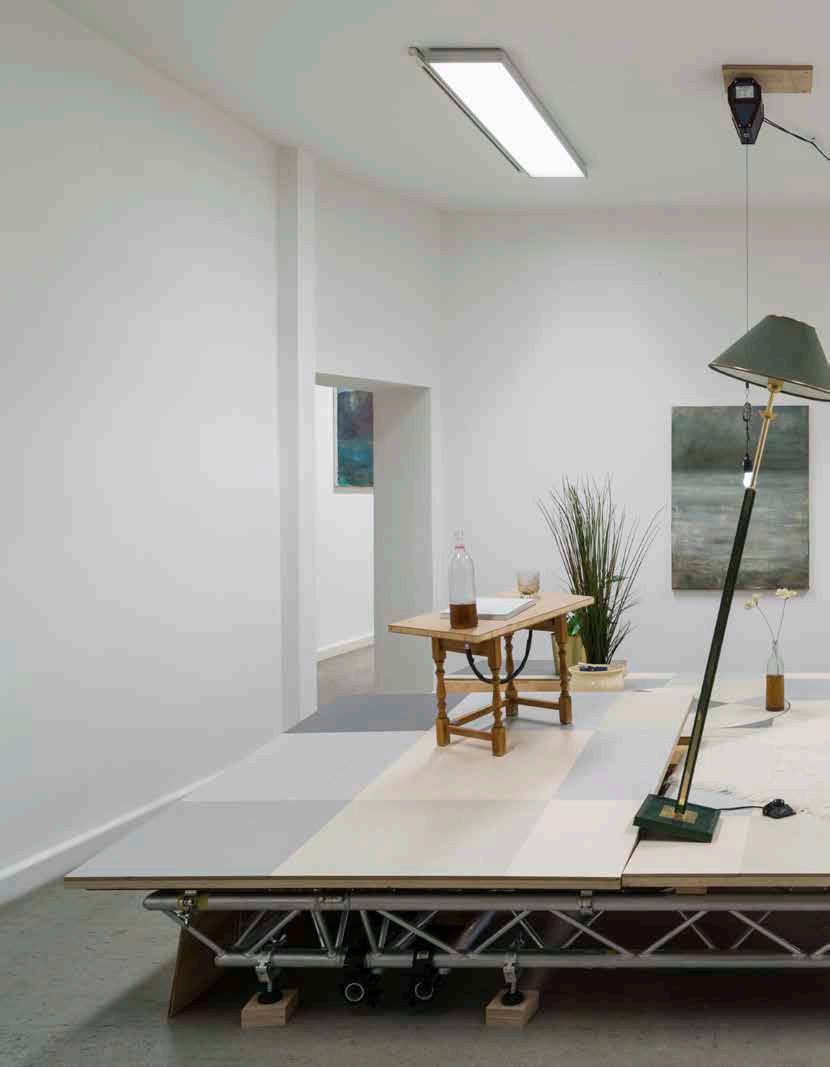


Clémentine M. Songe ist die fiktive Persona, als die Clément Layes mit Living Room arbeitet. In 2008 gründete Clément Layes Public in Private zusammen mit Jasna L. Vinovrški in Berlin. Seit 2011 kreieren sie sowohl Solos als auch große Gruppenstücke, die in Berlin und verschiedenen internationalen Kontexten in Europa und Nordamerika gezeigt wurden. An der Schnittstelle zwischen Choreografie, bildender Kunst und Philosophie liegt der Schwerpunkt der Arbeit in Beobachtungen des täglichen Lebens, mit dem Ziel, Choreografie als zeitgenössische Kunstform durch die Perspektive verschiedenster Medien weiterzuentwickeln. Bei Clémentine geht es darum, die Arbeit in eine neue Dimension zu bringen, die sich mit Weichheit, Zeit und Offenheit beschäftigt.
Clémentine M. Songe is the fictional persona as whom Clément Layes is working for Living Room. Clément Layes founded Public in Private with Jasna L. Vinovrški in 2008 in Berlin. Creating solos as well as large group pieces since 2011, their works were shown in Berlin and various international contexts in Europe and North America. At the interface between choreography, visual arts and philosophy, the point of the work lies in observations of daily life with the aim of further developing choreography as a contemporary art form through the perspective of a wide variety of media. With Clémentine, the idea is to bring the work to a new dimension dealing with softness, time and openness.
Clémentine M. Songe / Public in Private mit Morana Mažuran Jonas Maria Droste Ruth Waldeyer LIVING ROOM 09.12.2021 – 20.01.2022
Text: Morana Mažuran, Jonas Rutgeerts
Grafische Gestaltung: Marie Hareiter Fotos: Dieter Hartwig / Performance at Sophiensæle (Cover, S. 16–21), Morana Mažuran (S. 3, 9–13, 26), Aïsha Mia Lethen / PiP Studio im Flutgraben (S. 6, 15), Marcus Schneider / Installation at O&O Depot (S. 23, 24)
A production by Public in Private in coproduction with SOPHIENSÆLE and 0090. Funded by the Senate Department for Culture and Europe. Supported by O&O Baukunst and Flutgraben e.V.
Druck: Triggermedien, Berlin Auflage: 200 © 2022 O&O Depot